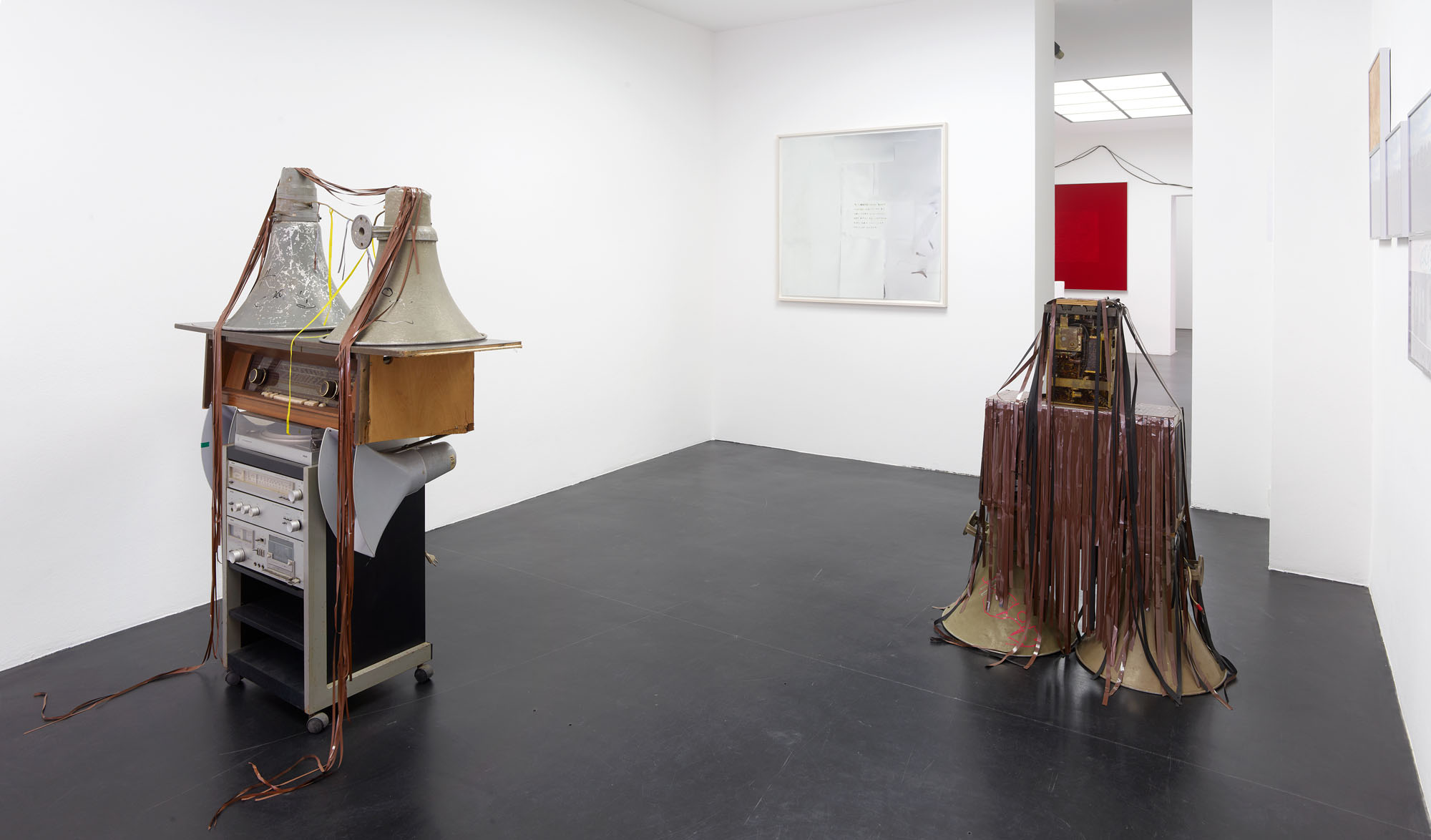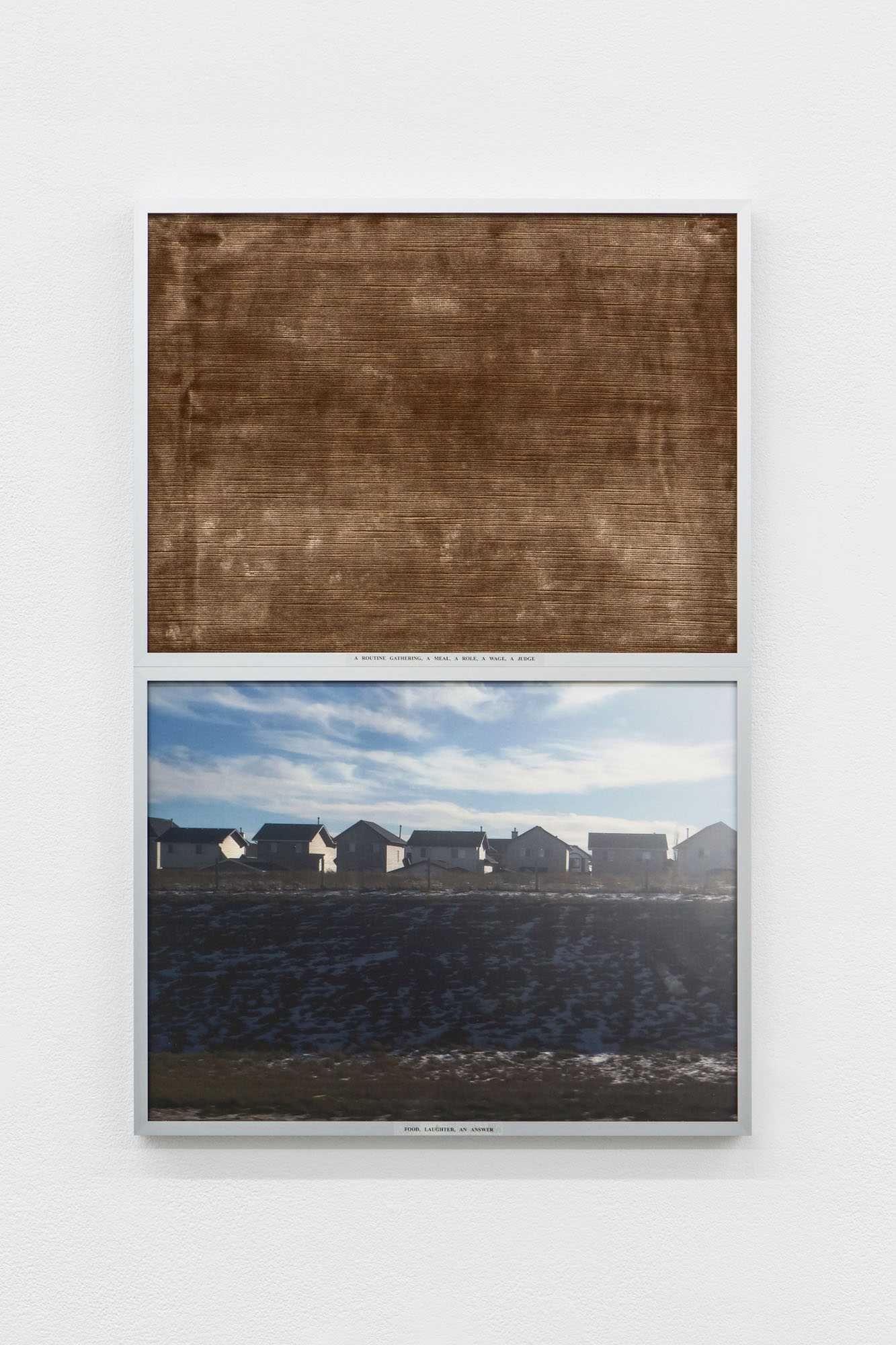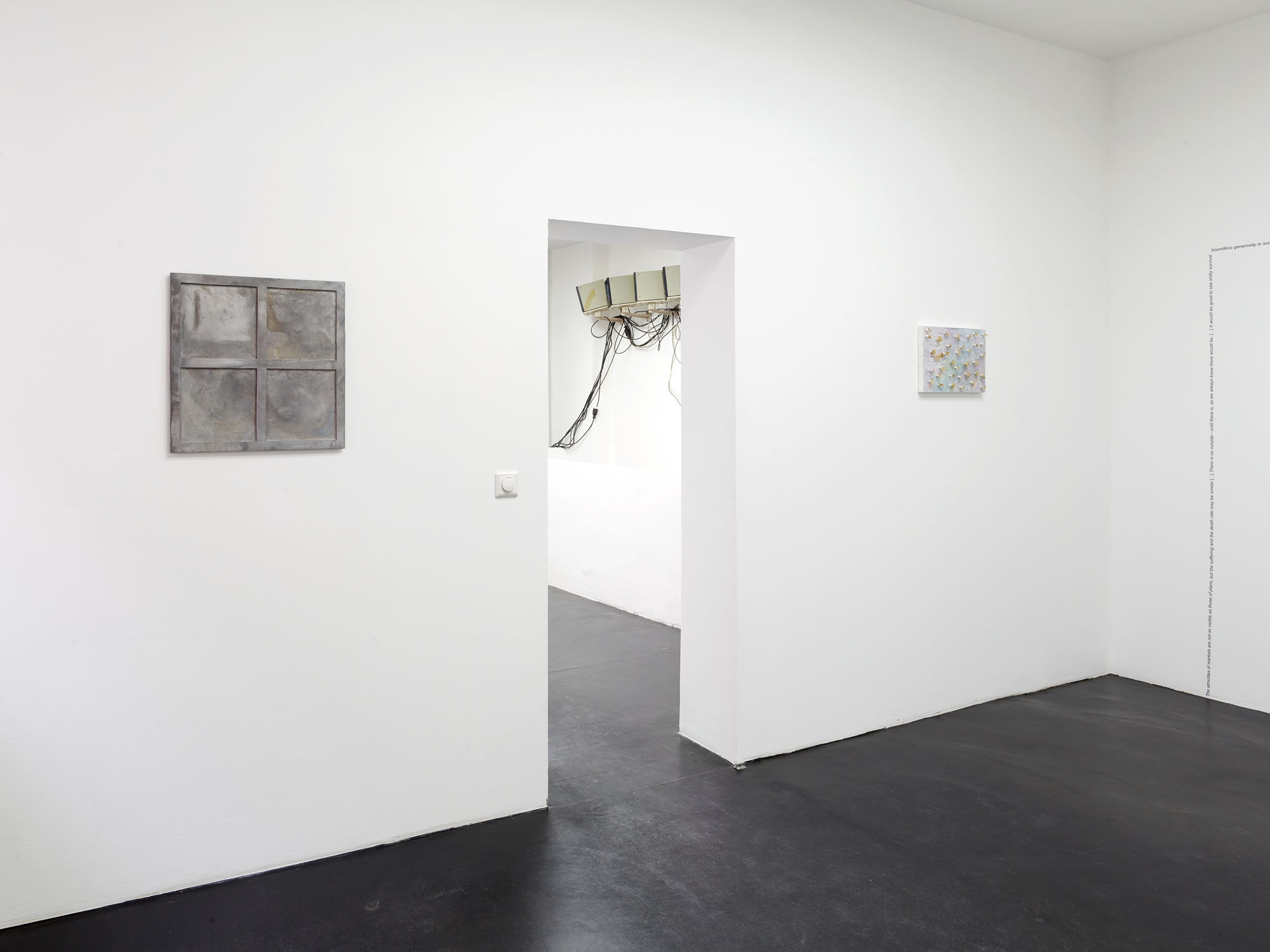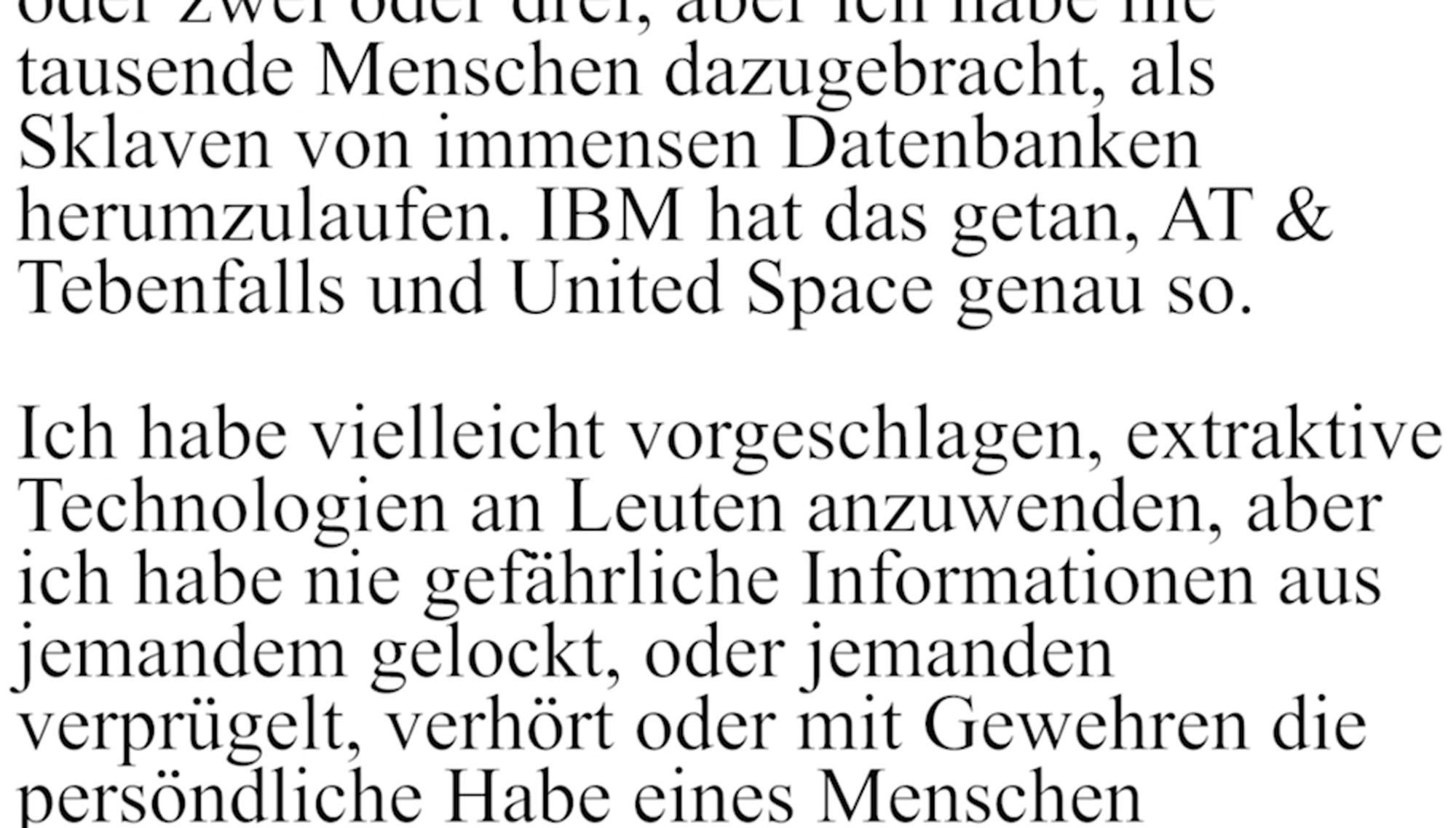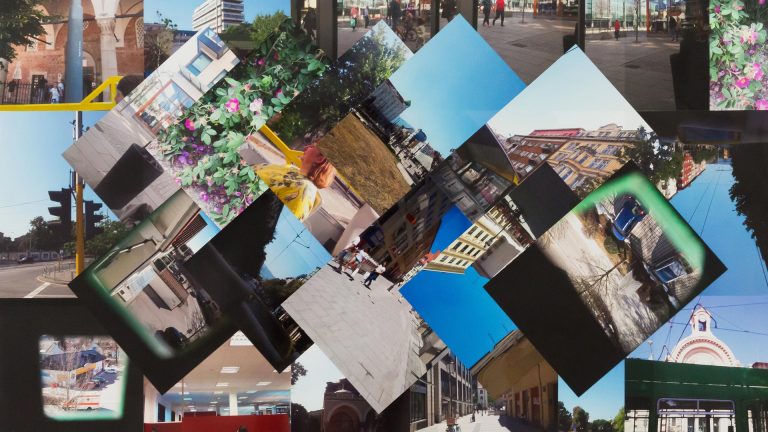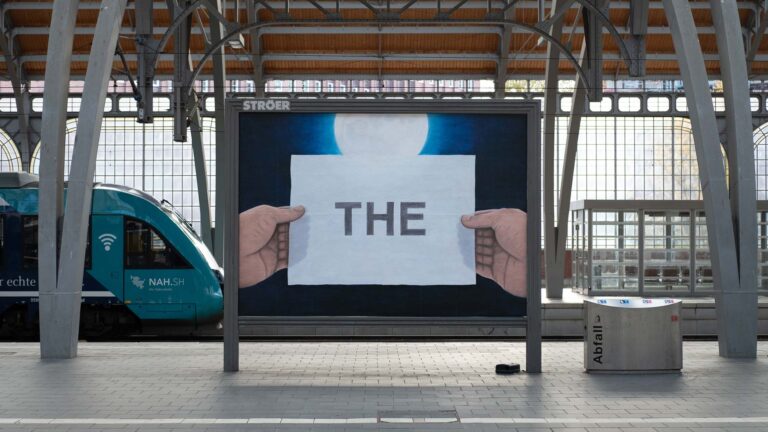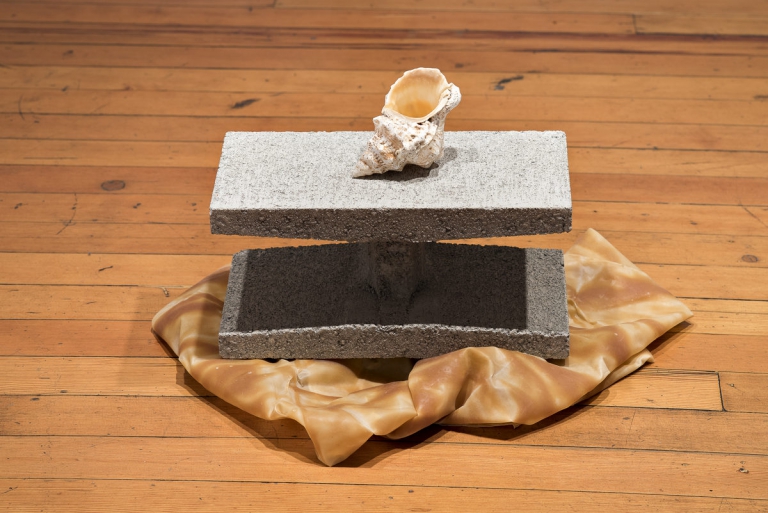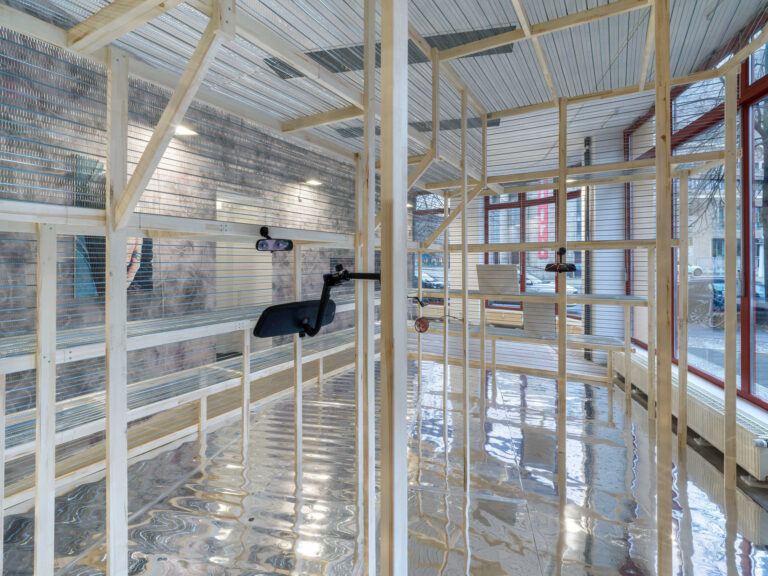Artists: Horst Ademeit, Rosa Aiello, Henri Chopin, Whitney Claflin, Cédric Eisenring, Tobias Madison, Sam Pulitzer, Julia Scher
Exhibition title: HAUS
Venue: DREI, Cologne, Germany
Date: September 7 – October 26, 2019
Photography: all images copyright and courtesy of the artists and DREI, Cologne
“In horror literature, a house is more than a building and less than a world, though it may resemble a building from without and an entire world from within. From without, it may seem self-contained and finite; from within, it may well extend forever, both spatially and temporally. Any horror house conforms to at least some of the following range of descriptions: it is bigger on the inside than on the outside; it contains or is a labyrinth; it is a library or a map; it is a microcosm of the world; it is a portal; it is coextensive with the underworld and/or the heavens above; it is the world tree; it occupies simultaneously the past, the present, and the future; it is alive; it tends to undergo a metamorphosis, which may have been hinted at throughout; it contains enigmatic, animated or undead objects; it makes mysterious sounds; it represents suppressed realities; it is coextensive with the minds of its inhabitant; in it, a hidden world reveals itself to the inhabitants and this world looks back at them; in it, occult and superhuman powers are at work that confront human thinking with the horizon of its possibilities; it drives its inhabitants mad and/or kills them in the course of the story. I— [1] entered. “Holy cow, it’s hot outside, My shoes are sweat-soaked, puddles have formed, it is awkward and I feel uncomfortable in my skin.” Exit gallerist.
As the end of the world had begun around that time, the curator mused, “Life in the Anthropocene implies that we are no longer at home and that our home is no longer comfortable, it feels as though our house has conspired against us. We become aware that the world has dimensions beyond our senses, that reality consists of depths that are beyond our comprehension. And also, our bodies are no longer what they used to be, our home. And in these dark corridors we came to realise only now that we ourselves are the moronic house spirits.” It made sense, he continued, “Nature is a haunted house—but Art—is a house that tries to be haunted. Horror speaks of this understanding that we live on a planet and not in a world, that the world is mortal, that the past is deeper than we can conceive and that the future is going to rip us apart. Horror vibrates to the planet. It is the planetary form of story, it is the revenge on the inhabitants, it turns the possessor into the possessed. ”
He continued to study the works and he shuddered again: “These are truly dark media, they show something where there should be nothing, and nothing where there should be something. There is a window that swallows the light, there is a door that leads nowhere, like a mirror without a reflection. I see the ectoplasm, the undead media, the ghosts in the devices, the grainy images, the spectral whispers of the tapes, the echoes of the past,
the ghostly static on the radio, the possessed computers, and the webcams of the dead.” Recalling reading something about this, he quoted and quivered, “These media convey that the world is never completely at our disposal and inaccessible to our senses, showing that all mediation harbors within itself a blind spot, that pulls us in like a black hole. To not understand is to know all too well. This art reveals an ontological horror, it is a world-for-us and also the world-without-us.”
Upon these fateful thoughts the curator collapsed. His whole body jittering and shaking, his lips mouthed these final words: “My heart it widens, my brain’s a black hole. A condition of horror is taking control. I’m one with this house and beyond i shall go. I vibrate with the planet—darkness and cold.”
—
Sources: Theodor W . Adorno, David Berman, John Clute, Mark Z. Danielewski, Emily Dickinson, Mark Fisher, Eugene Thacker
-Baptist Ohrtmann
HAUS, 2019, exhibition view, DREI, Cologne
HAUS, 2019, exhibition view, DREI, Cologne
HAUS, 2019, exhibition view, DREI, Cologne
Tobias Madison, If I could find what killed those of us who were different but whose difference gave us a reality beyond dying, 2019, Letter snippets glued on reflective foil, tape, 98,5 × 106,5 cm (38 3/4 × 41 7/8 inches), 106,5 × 114 cm (41 7/8 × 44 7/8 inches) (framed)
Tobias Madison, If I could find what killed those of us who were different but whose difference gave us a reality beyond dying, 2019, Letter snippets glued on reflective foil, tape, 98,5 × 106,5 cm (38 3/4 × 41 7/8 inches), 106,5 × 114 cm (41 7/8 × 44 7/8 inches) (framed)
Tobias Madison, If I could find what killed those of us who were different but whose difference gave us a reality beyond dying, 2019, Letter snippets glued on reflective foil, tape, 98,5 × 106,5 cm (38 3/4 × 41 7/8 inches), 106,5 × 114 cm (41 7/8 × 44 7/8 inches) (framed)
HAUS, 2019, exhibition view, DREI, Cologne
HAUS, 2019, exhibition view, DREI, Cologne
Rosa Aiello, Outcome, 2019, Upholstery fabric, acetate film, glue, aluminium frame, 31,2 × 41,2 cm (12 1/4 × 16 1/4 inches)
Rosa Aiello, Setting, 2019, Digital print, photo rag paper, acetate film, glue, aluminium frame, 31,2 × 41,2 cm (12 1/4 × 16 1/4 inches)
Rosa Aiello, Suspense, 2019, Digital print, photo rag paper, acetate film, glue, aluminium frame, 31,2 × 41,2 cm (12 1/4 × 16 1/4 inches)
Rosa Aiello, Conditioning, 2019, Digital print, photo rag paper, acetate film, glue, upholstery fabric, aluminium frames, Diptych: 62,4 × 41,2 cm (24 5/8 × 16 1/4 inches), Dyptich: 62,4 × 41,2 cm (24 5/8 × 16 1/4 inches)
Rosa Aiello, Configuration I, 2019, Digital print, photo rag paper, acetate film, glue, aluminium frame, 31,2 × 41,2 cm (12 1/4 × 16 1/4 inches)
Rosa Aiello, Configuration II, 2019, Digital print, photo rag paper, acetate film, glue, aluminium frames, Diptych: 62,4 × 41,2 cm (24 5/8 × 16 1/4 inches)
Rosa Aiello, A name, a word, or a sound repeated, 2019, Digital print, photo rag paper, acetate film, glue, aluminium frame, 31,2 × 41,2 cm (12 1/4 × 16 1/4 inches)
Rosa Aiello, Two stories take place in two separate rooms, until the two stories meet, 2019, Digital print, photo rag paper, acetate film, glue, aluminium frame, 31,2 × 41,2 cm (12 1/4 × 16 1/4 inches)
Rosa Aiello, The way the rooms of the two houses are arranged determines the flow of events, 2019, Digital print, photo rag paper, acetate film, glue, aluminium frame, 31,2 × 41,2 cm (12 1/4 × 16 1/4 inches)
Rosa Aiello, Because the house layout is determined by a standard, the people that live and ather in the house are standardized, 2019, Digital print, photo rag paper, acetate film, glue, aluminium frame, 31,2 × 41,2 cm (12 1/4 × 16 1/4 inches)
Rosa Aiello, Number of accounts of an incident, 2019, Digital print, photo rag paper, acetate film, glue, aluminium frames, 62,4 × 41,2 cm (24 5/8 × 16 1/4 inches)
HAUS, 2019, exhibition view, DREI, Cologne
HAUS, 2019, exhibition view, DREI, Cologne
Julia Scher, Atelier Trier, 1991, Four surveillance cameras, five b/w surveillance monitors, brackets, switchers, character generator, media player, cables, wires, power strips, video footage digitized from VHS, Dimensions variable
HAUS, 2019, exhibition view, DREI, Cologne
HAUS, 2019, exhibition view, DREI, Cologne
Cédric Eisenring, Untitled (Associate), 2019, Intaglio on velvet; aluminium shadow frame, 135 × 135 cm (53 1/8 × 53 1/8 inches), 137 × 137 cm (53 7/8 × 53 7/8 inches) (framed)
HAUS, 2019, exhibition view, DREI, Cologne
HAUS, 2019, exhibition view, DREI, Cologne
Tobias Madison, 2016, 2017, Cast lead, 45 × 45 × 2 cm (17 3/4 × 17 3/4 × 3/4 inches)
Tobias Madison, 2016, 2017, Cast lead, 45 × 45 × 2 cm (17 3/4 × 17 3/4 × 3/4 inches)
Tobias Madison, 2016, 2017, Cast lead, 45 × 45 × 2 cm (17 3/4 × 17 3/4 × 3/4 inches)
HAUS, 2019, exhibition view, DREI, Cologne
HAUS, 2019, exhibition view, DREI, Cologne
Whitney Claflin, civ, 2018, Acrylic, cigarette filters, wire, cigarette papers on linen, 11 × 16 inches (27,94 × 40,64 cm)
HAUS, 2019, exhibition view, DREI, Cologne
HAUS, 2019, exhibition view, DREI, Cologne
Julia Scher, Computer Niche (Transgressions), 1993 / 2019, Wall niche, white walls, wire mesh fence, cube monitor, vintage table, translation of an originally English text by the artist that she presented at “Transgressions Within The White Cube: Re-Considering Inter-Relationships Between Site, Object, Installation, Identity, and the Socio-Political”, a panel with Mark Dion, Renée Green, Sean Landers, Lois Nesbitt, and Julia Scher, organized and moderated by Joshua Decter at The School of Visual Arts, New York, November 1992; Loop, Dimensions variable
Julia Scher, Computer Niche (Transgressions), 1993 / 2019
Julia Scher, Computer Niche (Transgressions), 1993 / 2019
Julia Scher, Computer Niche (Transgressions), 1993 / 2019
Julia Scher, Computer Niche (Transgressions), 1993 / 2019
HAUS, 2019, exhibition view, DREI, Cologne
Horst Ademeit, 0333, 06.09.1991, Hand-edited Polaroid, 11 × 9 cm (4 3/8 × 3 1/2 inches)
Horst Ademeit, 0333, 06.09.1991, Hand-edited Polaroid, 11 × 9 cm (4 3/8 × 3 1/2 inches)
Horst Ademeit, 4256, 09.11.2000, Hand-edited Polaroid, 11 × 9 cm (4 3/8 × 3 1/2 inches)
Horst Ademeit, 4256, 09.11.2000, Hand-edited Polaroid, 11 × 9 cm (4 3/8 × 3 1/2 inches)



